|
|
|
Veerapandiya Kattabomman
வீரபாண்டிய
கட்டபொம்மன்
3 January 1760 - 16 October
1799
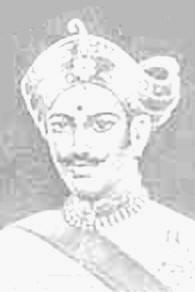 "...Kattabomman
faced the last moments of his life in a way
becoming of a rebel leader. Major John
Bannerman writes to the Madras Government,
17 October, 1799, thus: 'it may not be
amiss here to observe that the manner and
behaviour of the Poligar during the whole time
of his being before those who were assembled
yesterday at the examination, which took place
were undaunted and supercilious. He frequently
eyed the Etiapore Poligar (Poligar of
Ettayapuram), who had been so active in
attempting to secure his person, and the
poligar of Shevighergy with an appearance of
indignant contempt and when he went out to be
executed, he walked with a firm and daring air
and cast looks of sullen contempt on the
poligars to his right and left as he
passed..." "...Kattabomman
faced the last moments of his life in a way
becoming of a rebel leader. Major John
Bannerman writes to the Madras Government,
17 October, 1799, thus: 'it may not be
amiss here to observe that the manner and
behaviour of the Poligar during the whole time
of his being before those who were assembled
yesterday at the examination, which took place
were undaunted and supercilious. He frequently
eyed the Etiapore Poligar (Poligar of
Ettayapuram), who had been so active in
attempting to secure his person, and the
poligar of Shevighergy with an appearance of
indignant contempt and when he went out to be
executed, he walked with a firm and daring air
and cast looks of sullen contempt on the
poligars to his right and left as he
passed..."
 On 248th Birth Anniversary of Veerapandiya
Kattabomman
On 248th Birth Anniversary of Veerapandiya
Kattabomman
-
இரா.இராமச்சந்திரன்,
திருச்சி,
January 2008
"
....தாய்ப்புலி
தான்
ஈன்ற
குட்டிகளை
தன்னுயிர்
போனாலும்
கவர்ந்து
செல்ல
யாருக்கும்
அனுமதியளிக்காது.
...
இதற்கு
உதாரணமாகத்
திகழந்தவர்
கட்டபொம்மன்.
தம்
எதிர்கால
மக்கள்
சுதந்திரமாக
வாழவேண்டு
மென்பதற்காக
கொண்ட
கொள்கைகளை
கடைசிவரை
காப்பாற்றி
தமிழகத்தின்
வரலாற்றில்
ஆழமாக
பதியப்பட்டு
நிற்கின்றார்..."
 Major John Bannerman on
the hanging of Veerapandiya Kattabomman -
letter to Madras Government of 17 October
1799 Major John Bannerman on
the hanging of Veerapandiya Kattabomman -
letter to Madras Government of 17 October
1799
 Legends from the
South:Veerapandiya
Kattabomman Legends from the
South:Veerapandiya
Kattabomman
 Kattabomman
Memorial Fort Kattabomman
Memorial Fort
 Veerapandiya Kattabomman & the
Poligar rebellion - N.
Rajendran in National Movement in Tamil
Nadu, 1905-1914 -
Agitational Politics and State
Coercion Veerapandiya Kattabomman & the
Poligar rebellion - N.
Rajendran in National Movement in Tamil
Nadu, 1905-1914 -
Agitational Politics and State
Coercion
"..Collector
Jackson singled out Kattabomman Nayak of
Panchalamkurichi as the main leader of the
rebellion. That came to be known as the First
Poligari War was declared on 5 September
1799. Although Kattabomman managed to escape
from the field of battle, he was captured a
month later in Pudukottai. After a summary
trial, he was sentenced to death by Major
Bannerman, Commander of the East India
Company troops. He was
publicly hanged near Kayattar Fort, close to
the town of Tirunelveli, in front of fellow
poligars who had been summoned to witness the
execution..."
|
 Major John Bannerman on the hanging of
Veerapandiya Kattabomman letter to Madras
Government of 17 October 1799 R. C , Vol 98, pp:
2877-2884" quoted by K.Rajayyan in History of Madurai
(1736 - 1801) at p.355
Major John Bannerman on the hanging of
Veerapandiya Kattabomman letter to Madras
Government of 17 October 1799 R. C , Vol 98, pp:
2877-2884" quoted by K.Rajayyan in History of Madurai
(1736 - 1801) at p.355 |
"...Kattabomman faced the
last moments of his life in a way becoming of a
rebel leader. Major John Bannerman
writes to the Madras Government, 17 October,
1799, thus: 'it may not be amiss here to
observe that the manner and behaviour of the
Poligar during the whole time of his being
before those who were assembled yesterday at
the examination, which took place were
undaunted and supercilious. He frequently eyed
the Etiapore Poligar (Poligar of
Ettayapuram), who had been so active in
attempting to secure his person, and the
poligar of Shevighergy with an appearance of
indignant contempt and when he went out to be
executed, he walked with a firm and daring air
and cast looks of sullen contempt on the
Poligars to his right and left as he passed. It
was reported to me that in his way to the place
of execution he expressed some anxiety for his
brother (Kumaraswamy Nayak) alone: and said,
when he reached the foot of the Tree on which
he was hanged, that he then regretted having
left his fort, in the defence of which it would
have been better for him to have
died'.
|
 Legends from the South:Veerapandiya Kattabomman
Courtesy The Sanmar Group
Legends from the South:Veerapandiya Kattabomman
Courtesy The Sanmar Group
|
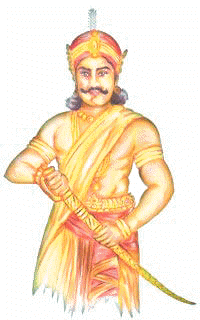 "The struggle for
freedom from the British, saw the emergence of
many patriots who fought, made sacrifices and
even lost their lives defending the country.
Exhibiting great courage, Tamils were among those
who sowed the seeds for the freedom movement. One
such pioneer was Veerapandiya Kattabomman. "The struggle for
freedom from the British, saw the emergence of
many patriots who fought, made sacrifices and
even lost their lives defending the country.
Exhibiting great courage, Tamils were among those
who sowed the seeds for the freedom movement. One
such pioneer was Veerapandiya Kattabomman.
Eighteen kilometres north
west of Tirunelveli lies the hamlet of
Panchalankurichi, a place of historical
significance. The chieftains ruling
Panchalankurichi put up stiff resistance against
the British East India Company, between 1798 and
1801.
Veerapandiya Kattabomman was
a fearless chieftain who refused to bow down to
the demands of the British for agricultural tax
on native land, a brave warrior who laid down his
life for his motherland. The fight he launched in
Panchalankurichi has been hailed as the
inspiration behind the first battle of
independence of 1857, which the British called
the Sepoy Mutiny.
Azhagiya Veerapandiapuram
(Ottapidaram of today) was ruled by Jagaveera
Pandiyan. He had a minister Bommu who had
migrated from Andhra Pradesh to Tamil Nadu who
was a brave warrior. He was known as Gettibommu
in Telugu to describe his strength and fighting
qualities. This, over a period of time, became
Kattabomman in Tamil. Kattabomman ascended the
throne after Jagaveera Pandiyan, who had no
issue, and later came to be known as Adi
Kattabomman, the first of the clan of
Kattabomman.
Legend has it that during a
hunting trip into the forests of Salikulam (close
to Azhagiya Pandiyapuram) Kattabomman watched the
spectacle of a hare chasing seven hounds.
Kattabomman was amazed at this miracle. Believing
that the land possessed great powers that could
instil courage in people, he built his fort there
and named it Panchalankurichi.
Born in this clan of Adi
Kattabomman was Veerapandiyan on January 3, 1760
� the 47th king of
Panchalankurichi � to Jagaveera
Kattabomman and Arumugathammal. He had two
younger brothers Dalavai Kumarasami and
Duraisingam. Veerapandiyan was fondly called
�Karuthaiah�
(the black prince), and Dalavai Kumarasami,
�Sivathaiah�
(the white prince). Duraisingam, a good orator,
earned the sobriquet
�Oomaidurai�,
which actually meant the very opposite
� the dumb prince.
On February 2, 1790,
Veerapandiyan, thirty, became the king of
Panchalankurichi. The Nawab of Arcot who had
borrowed huge sums of money from the East India
Company gave them the right to collect taxes and
levies from the southern region in lieu of the
money he had borrowed. The East India Company
took advantage of the situation and plundered all
the wealth of the people in the name of tax
collection. All the
�poligars� paid
taxes except Veerapandiyan.
Kattabomman refused to pay
his dues and for a long time refused to meet
Jackson the Collector of the East India Company.
Finally, he met Jackson at
�Ramalinga
Vilasam�, the palace of
Sethupathi of Ramanathapuram. The meeting ended
in a skirmish in which the Deputy Commandant of
the Company�s forces, Clarke was
slain. Kattabomman and his men fought their way
to freedom and safety, but Thanapathi Pillai,
Kattabomman�s secretary was
taken prisoner.
The Commission of Enquiry
that went into the incident fixed the blame on
Jackson and relieved him of his post, thinking
the Company�s plan to take over
the entire country gradually could be marred by
Jackson�s fight with
Veerapandiya Kattabomman. The new Collector of
Tirunelveli wrote to Kattabomman calling him for
a meeting on 16th March, 1799. Kattabomman wrote
back citing the extreme drought conditions for
the delay in the payment of dues and also
demanded that all that was robbed off him at
Ramanathapuram be restored to him. The Collector
wanted the ruling house of Sethupathis to prevent
Kattabomman from aligning himself with the
enemies of the Company and decided to attack
Kattabomman.
Kattabomman refused to meet
the Collector and a fight broke out. Under Major
Bannerman, the army stood at all the four
entrances of Panchalankurichi�s
fort. At the southern end, Lieutenant Collins was
on the attack. When the fort�s
southern doors opened, he was killed by
Kattabomman�s
warriors.
After suffering heavy
losses, the English decided to wait for
reinforcements from Palayamkottai. Sensing that
his fort could not survive a barrage from heavy
cannons, Kattabomman left the fort that
night.
A price was set on
Kattabomman�s head. Thanapathi
Pillai and 16 others were taken prisoners.
Thanapathi Pillai was executed and his head
perched on a bamboo pole was displayed at
Panchalankurichi. Veerapandiya Kattabomman stayed
at Kolarpatti at Rajagopala
Naicker�s house where the forces
surrounded the house.
Kattabomman and his aides
fled from there and took refuge in the
Thirukalambur forests close to Pudukkottai.
Bannerman ordered the ruler of Pudukkottai to
arrest Kattabomman. Accordingly, Kattabomman was
captured and on October 16, 1799 the case was
taken up (nearly three weeks after his arrest
near Pudukkottai). After a summary trial,
Kattabomman was hanged unceremoniously on a
tamarind tree. The fort of Panchalankurichi was
razed to the ground and all of
Kattabomman�s wealth was looted
by the English soldiers.
A fort constructed by
the Tamil Nadu Government at Panchalankurichi in
1972 stands as a monument to this great hero
from the south who played a pivotal role in the
freedom movement of our country. "
|
|
 Kattabomman Memorial
Fort
Kattabomman Memorial
Fort
|
|
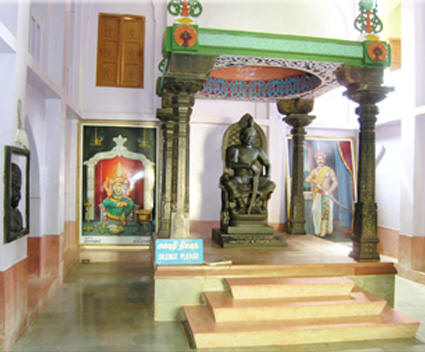
Kattabomman Statute inside Kattabomman Memorial
Fort
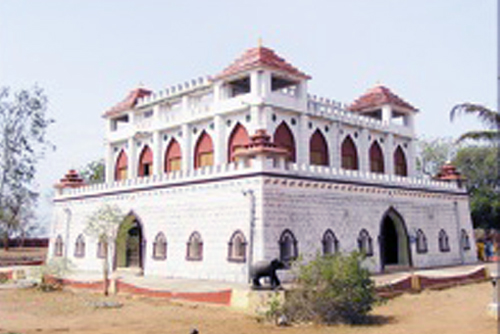
|
Panchalankurichi, is a small
but historic village around 70km from Tirunelveli
and18 km from Tuticorin. From here the great
warrior Katta Bomman popularly known as
'Veerapandiya Kattabomman' raised his voice against
the British regime in the 17th Century A.D.
The existing memorial fort was constructed in 1974,
by the Government of Tamil Nadu. The memorial Hall,
has beautiful paintings on the walls depicting the
heroic deeds of the saga which gives a good idea
about the history of the period. A cemetery of
British soldiers are also seen near the fort. The
remnants of the old fort is protected by the
Archaeological Survey of India. At Kayatar, near
Tirunelveli the place where he was hanged, there is
another memorial for Kattabomman. |
 Veerapandiya Kattabomman & the
Poligar rebellion Veerapandiya Kattabomman & the
Poligar rebellion
- N.Rajendran in National Movement in Tamil Nadu, 1905-1914,
Agitational Politics and State
Coercion |
|
In Tamil
Nadu, as in other parts of India, the earliest
expressions of opposition to British rule took
the form of localised rebellions and uprisings.
Chief among these was the revolt of the
palayakkarargal (poligars) against the East India
Company in 1799.
The poligari
system had evolved with the extension of
Vijayanagar rule into Tamil Nadu. Each poligar
was the holder of a territory or palayam (usually
consisting of a few villages), granted to him in
return for military service and
tribute.
Where
circumstances allowed, the poligars naturally
tended to place less emphasis on performing their
duties and more on enhancing their own powers.
Given their numerical strength, extensive
resources, local influence and independent
attitude, the poligars came to constitute a
powerful force in the political system of south
India. They regarded themselves as independent,
sovereign authorities within their respective
palayams, arguing that their lands had been
handed down to them across a span of sixty
generations Such claims of course were to be
brushed aside by the East India
Company...
The East India Company,
eager for revenue, opposed the manner and scale
in which the poligars collected taxes from the
people. The issue of
taxation�more specifically, who
was to collect it, the traditional rulers or the
rapacious new collectors from overseas
�lay at the root of the
subsequent uprising. As one British Collector
noted:
I again repeated that. . .
unless the poligar were deprived of his power,
and my recommendations went to the fullest
extent of the measure, the Company's investment
would be materially checked, the weavers
residing in the Panchalamkurichi palayam would
be stripped off their property, and the largest
part of the advances made to them by the
commercial resident exposed to considerable
danger.
...The early struggle
between the poligars of south and East India
Company, although essentially a battle over tax
collection, had a strong political dimension. The
English treated the poligars, perceived as a
rival power, as their inveterate enemies,
allowing their hostility full expression in their
accounts...
When in 1799 the poligars of
Tirunelveli District rose in open rebellion, the
East India Company took all possible measures to
check the spread of the uprising. A detachment of
Company troops was speedily deployed against the
Tirunelveli poligars, while dire warnings were
issued to poligars in other parts of the south
not to join the rebellion. The Company, which
regarded the poligars as the 'scourge of the
country', determined to deprive the ringleaders
of their palayats and punish them in an exemplary
fashion.
Collector Jackson singled out Kattabomma
Nayak of Panchalamkurichi as the main leader of
the rebellion. That came to be known as the
First Poligari War was declared on 5 September
1799. Although Kattabomman managed to escape
from the field of battle, he was captured a
month later in Pudukottai. After a summary
trial, he was sentenced to death by Major
Bannerman, Commander of the East India Company
troops. He was publicly hanged near Kayattar
Fort, close to the town of Tirunelveli, in
front of fellow poligars who had been summoned
to witness the execution.
Subramania Pillai, a close
associate of Kattabomma Nayak, was also publicly
hanged and his head was fixed on a pike at
Panchalamkurichi. Soundra Pandian Nayak, another
rebel leader, was brutally done to death by
having his brains dashed against a village
wall.
Despite the exemplary repression of 1799,
however, rebellion broke out again in 1800, this
time in a more cohesive and united manner.
Although the 1800-1801 rebellion was to be
categorised in British records as the Second
Poligari War, it assumed a much broader character
than its predecessor. It was directed by a
confederacy consisting of Marudu Pandian of
Sivaganga, Gopala Nayak of Dindugal, Kerala Verma
of Malabar and Krishnappa Nayak and Dhoondaji of
Mysore. The insurrection, which broke out in
Coimbatore in June 1800, soon spread to
Ramanathapuram and Madurai. By May 1801, it had
reached the northern provinces, where Marudu
Pandian, Melappan and Puttur provided the
leadership. Oomathurai, the brother of Kattabomma
Nayak, emerged as a key leader. In February 1801,
Oomathurai and two hundred men by a clever
stratagem took control of Panchalamkuriclli Fort,
in which Oomathurai's relatives were
imprisoned.
Its fort now re-occupied and
reconstructed by rebel forces Panchalamkurichi
became the nerve centre of the uprising. British
dismay was boundless. As one eyewitness put
it,
' . . . to our utter
astonishment, we discovered that the walls,
which had been entirely levelled, were now
rebuilt, and fully manned by about fifteen
hundred poligars.'
Three thousand armed men of
Madurai and Ramanathapuram, despatched by Marudu
Pandian, joined up with the Panchalamkurichi
forces. However, British military superiority
having just destroyed the far more formidable
challenge posed by Tipu Sultan in Mysore, quickly
asserted itself. The poligar forces based at
Panchalamkurichi were crushed and, by the orders
of the colonial government, the site of the
captured fort was ploughed up and sowed with
castor oil and salt so that it should never again
be inhabited.
The
colonial forces quickly overpowered the
remaining insurgents. The Marudu brothers and
their sons were put to death, while Oomathurai
and Sevatiah were beheaded at Panchalamkurichi
on 16 November, 1801. Seventy-three of the
principal rebels were sentenced to perpetual
banishment. So savage and extensive was the
death and destruction wrought by the English
that the entire region was left in a state of
terror.
The suppression of the
poligar rebellions of 1799 and 1800-1801 resulted
in the liquidation of the influence of the
chieftains. Under the terms of the Carnatic
Treaty (31 July, 1801), the British assumed
direct control over Tamil Nadu. The poligari
system, which had flourished for two and a half
centuries, came to a violent end and the Company
introduced a zamindari settlement in its
place.
While it is obviously
premature and misleading to attach the term
'nationalist' to the struggle of the poligars, or
to portray it as some kind of mass movement, the
uprising does appear to have attracted some
popular support. In subsequent years, a good deal
of legend and folklore would develop around
Kattabomman and the Marudu brothers.
Long after Kattabomman's
execution, Kayattar, his place of death, remained
a place of political pilgrimage. In his
Tinnevelly Gazetteer of 1917, H. R. Pate notes
the presence in Kayattar of 'a great pile of
stones of all sizes, which represents the
accumulated offerings by wayfarers of the past
hundred years'. Folk songs recalling the heroism
of the poligar leaders remain alive in Tamil Nadu
to this day..."
|
 வீரபாண்டிய
கட்டபொம்மன்
- On the 248th Birth Anniversary
இரா.இராமச்சந்திரன்,
திருச்சி,
3 January 2008
வீரபாண்டிய
கட்டபொம்மன்
- On the 248th Birth Anniversary
இரா.இராமச்சந்திரன்,
திருச்சி,
3 January 2008 |
"
....தாய்ப்புலி
தான்
ஈன்ற
குட்டிகளை
தன்னுயிர்
போனாலும்
கவர்ந்து
செல்ல
யாருக்கும்
அனுமதியளிக்காது.
... இதற்கு
உதாரணமாகத்திகழந்தவர்
கட்டபொம்மன்.
தம்
எதிர்கால
மக்கள்
சுதந்திரமாக
வாழவேண்டுமென்பதற்காக
கொண்டகொள்கைகளை
கடைசிவரை
காப்பாற்றி
தமிழகத்தின்
வரலாற்றில்
ஆழமாக
பதியப்பட்டு
நிற்கின்றார்..."
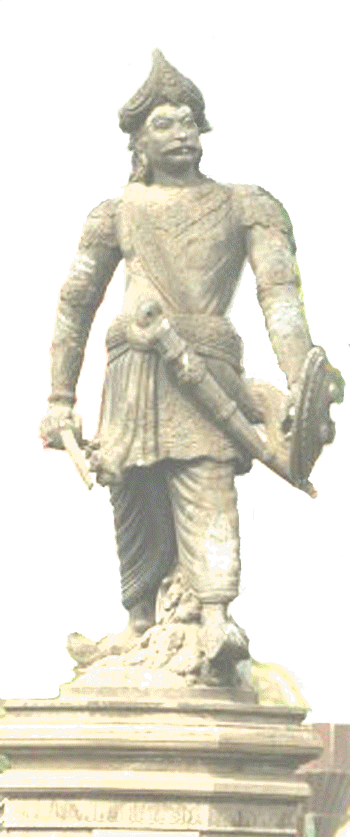 உலகின்
உயிரின
பரிணாம
வளர்ச்சியில்
மனிதன்
என்ற
படைப்பு
மிக
உன்னதமாகக்கருதப்படுகின்றது.
உலகம்
தோன்றியது
முதல்
இன்றைய
காலகட்டம்
வரை
பிறந்து
மறைந்தவர்கள்
எல்லோரும்
நம்
நினைவில்
நிற்கமுடியாத
நிலை.
ஆனால்
காலத்தால்
மறைக்க
முடியாத
மனிதர்கள்
இன்றும்
நினைவில்
வாழ்ந்து
கொண்டுதான்
இருக்கின்றார்கள்.
அத்தகைய
சிறப்பை
அவர்கள்
பெற்றதற்கு
காரணம்
அவர்களின்
தனித்தன்மை
வாய்ந்த
அவர்களின்
குணாதியங்கள்கள்தான்.
அப்படி
வாழ்ந்து
மறைந்த
மாவீரனாக
நம்
நெஞ்சங்களில்
வாழ்ந்து
கொண்டிருப்பவர்களில்
ஒருவர்
வீரபாண்டிய
கட்டபொம்மன். உலகின்
உயிரின
பரிணாம
வளர்ச்சியில்
மனிதன்
என்ற
படைப்பு
மிக
உன்னதமாகக்கருதப்படுகின்றது.
உலகம்
தோன்றியது
முதல்
இன்றைய
காலகட்டம்
வரை
பிறந்து
மறைந்தவர்கள்
எல்லோரும்
நம்
நினைவில்
நிற்கமுடியாத
நிலை.
ஆனால்
காலத்தால்
மறைக்க
முடியாத
மனிதர்கள்
இன்றும்
நினைவில்
வாழ்ந்து
கொண்டுதான்
இருக்கின்றார்கள்.
அத்தகைய
சிறப்பை
அவர்கள்
பெற்றதற்கு
காரணம்
அவர்களின்
தனித்தன்மை
வாய்ந்த
அவர்களின்
குணாதியங்கள்கள்தான்.
அப்படி
வாழ்ந்து
மறைந்த
மாவீரனாக
நம்
நெஞ்சங்களில்
வாழ்ந்து
கொண்டிருப்பவர்களில்
ஒருவர்
வீரபாண்டிய
கட்டபொம்மன்.
03-01-1760
ல்
அழகிய
வீரபாண்டியபுரத்தில்
(இன்றைய
ஒட்டப்பிடாரம்)பிறந்தார்.
இவருடைய
தந்தை
ஜெகவீரபாண்டியன்.
தாய்
ஆறுமுகத்தம்மாள்.
கட்டபொம்மனின்
முன்னோர்கள்
தெலுங்கு
தேசத்தை
சேர்ந்தவர்கள.
விஜயநகர
பேரரசினரால்
புலம்
பெயர்ந்தவர்கள்
எனக்கருதபபடுகின்றது.
.இவர்களின்
மூனறு
புதல்வர்கள்தான்
கருத்தையா
என்ற
வீரபாண்டிய
கட்டபொம்மன்,
தளவாய்
குமாரசாமி
என்ற
துரைசிங்கம்
மற்றும்
செவத்தையா
என்ற
ஊமைத்துரை.
இவர்களின்
முன்னோர்கள்
தெலுங்கு
நாட்டின்
பிரசித்திபெற்றவர்கள்.
கெட்டி
பொம்முலு
என
வீரத்துக்கு
அடையாளமாக
சொல்லப்படும்
சாஸ்த்தா
அய்யணசாமி
என்ற
தெய்வத்தின்
பெயரால்
அழைக்கப்பெற்றவர்கள்.
அந்த
வீரத்துக்
காவல்
தெய்வமாகக்கருதப்பட்டதனால்
என்னவோ
பிழைக்க
வந்த
வெள்ளையர்களுக்கு
கட்டபொம்மன்
ஒரு
சிம்மசொப்பனமாகத்திகழ்ந்தார்.
சங்க
காலத்தமிழ்
காப்பியங்களில்
வீரத்தமிழ்மன்னர்கள்
தம்
நாட்டு
மக்களின்
துயர்
தீர்க்க
தன்னுயிரையும்
தர
இசைந்தார்கள்.
தாய்ப்புலி
தான்
ஈன்ற
குட்டிகளை
தன்னுயிர்
போனாலும்
கவர்ந்து
செல்ல
யாருக்கும்
அனுமதியளிக்காது.
அவ்வாறே
ஒரு
மன்னன்
தன்
நாட்டு
மக்களை
காக்க
வேண்டும்
என்ற
எண்ணம்
கொண்டவர்களாக
அன்றைய
தமிழ்
மன்னர்கள்
திகழ்ந்தார்கள்
என
புறநானூற்றுப்பக்கங்கள்
நமக்கு
பறைசாற்றுகின்றன.
இதற்கு
உதாரணமாகத்திகழந்தவர்
கட்டபொம்மன்.
தம்
எதிர்கால
மக்கள்
சுதந்திரமாக
வாழவேண்டுமென்பதற்காக
கொண்டகொள்கைகளை
கடைசிவரை
காப்பாற்றி
தமிழகத்தின்
வரலாற்றில்
ஆழமாக
பதியப்பட்டு
நிற்கின்றார்.
பாஞ்சாலங்குறிச்சியை
ஆண்ட
கட்டபொம்மனின்
மூதாதையர்களில்
ஒருவர்
காலத்தில்
நடந்ததாகக்கருதப்படும்
கதைகளில்
ஒன்று
இன்றும்
பேசப்படுகின்றது.
ஒரு
நாள்
வேட்டையாடும்
நேரத்தில்,
வேட்டை
நாய்களினால்
துரத்தப்பட்டு
வந்த
முயலொன்று
குறிப்பிட்ட
இடத்தில்
வந்தவுடன்
வேட்டை
நாய்களை
நோக்கி
முயல்
சீறிப்பாய்ந்ததாகவும்
அதைக்கண்ணுற்ற
அன்றைய
கட்டபொம்மர்
அதுவே
தாம்
கோட்டை
கட்டுவதற்கு
உகந்த
இடம்
எனத்தீiமானித்து
அவ்விடத்திலேயே
பாஞ்சாலங்குறிச்சி
கோட்டையை
நிறுவியதாகவும்
கூறப்படுகின்றது.
கருத்தையா
என்ற
வீரபாண்டியன்
02.02.1790ல்
கட்டபொம்மர்களின்
வாரிசாக
கருதப்பட்டு
ஆட்சி
அமைக்க
அன்றைய
மதுரைப்பாளையர்க்காரர்களால்
அனுமதிக்கப்பட்டார்.
கட்டபொம்மன்
பாஞ்சாலங்குறிச்சியின்
மன்னனாகப்
பொறுப்பேற்றார்.
1736
க்கு
முன்
ஏறத்தாழ
இரண்டு
நூற்றாண்டுகள்
மதுரை
நாயக்கர்
வம்ச
அரசர்களால்
பரிபாலனம்
செய்யப்பட்டு
வந்தது.
அதன்
பிறகு
சந்தாப்
சாகேப்
ஆர்கோட்
என்பவரால்
மதுரை
அங்கு
கடைசியாக
ஆண்ட
ராணியிடமிருந்து
பறிக்கப்பட்டு
நவாப்
ஆட்சியின்
கீழ்
கொண்டு
வரப்பட்டது.
இக்காலகட்டத்தில்
மக்களின்
வரிப்பணம்
பெருமளவில்
சுரண்டப்பட்டதின்
காரணமாகவும்
மக்கள்
மிக்க
அதிருப்தி
கொண்டிருந்தனர்.
அத்துடன்
இஸ்லாமிய
ஆட்சிமுறையை
பெரும்பாலான
பாளையக்காரர்கள்
எதிர்க்கத்துணிந்தனர்.
இத்தகைய
போக்குகள்
இறுதியில்
ஆர்க்காடு
அரசினை
வெள்ளையர்களிடம்
நாட்டை
அடகு
வைக்கும்
நிலைக்கு
கொண்டு
சென்றது.
சரியான
தருணம்
பார்த்திருந்த
ஆங்கிலேயர்கள்
ஆர்க்காடு
நவாப்
அரசுக்கு
கொடுத்துள்ள
கடனுக்காக
நவாப்பிடமிருந்து
வரிவசுலிக்கும்
அதிகாரத்தை
தங்கள்
கையில்
எடுத்துக்கொண்டு
மக்களிடமிருந்து
தாறுமாறாக
வரி
என்ற
பெயரில்
கொள்ளையடிக்க
ஆரம்பித்தார்கள்.
வரியை
மக்களிடமிருந்து
வாங்கிக்கொடுக்காத
பாளையக்காரர்கள்
கொடுமைக்காளானார்கள்.
இத்தகைய
நிலை
ஏறத்தாழ
40,50
ஆண்டுகள்
நீடித்த
நிலையில்தான்
பாஞ்சாலஞ்குறிச்சியில்
கட்டபொம்மன்
ஆட்சிக்கு
வந்தார்.
மக்களின்
வரிப்பணம்
பாலாக்கப்பட்டு
நிர்வாகம்
தறிகெட்டுக்கிடந்த
ஒரு
காலகட்டத்தில்
மக்களை
புரட்சியிலிருந்து
ஒடுக்குவதற்கு
ஆங்கிலேயர்கள்
கடுமையான
நடவடிக்கைகளை
மேற்கொண்டார்கள்.
இத்தகைய
போக்கு
பிரச்சனைகளை
மேலும்
மோசமாக்குவதாக
அமைந்தது.
இத்தகைய
குழப்பமான
நிலையில்
ஆங்கிலேயர்கள்
தங்களுக்கேயுரித்தான
பிரித்தாழும்
சதிவேலைகளை
மேற்கொண்டு
மக்களிடம்
ஒற்றுமையின்மையை
ஏற்படுத்தினார்கள்.
இக்காலகட்டத்தில்
ஆஙகிலேயரின்
ஒடுக்குமுறைக்கு
சற்றும்
சளைக்காமல்
கட்டபொம்மன்
அவர்களுக்கு
வரி
சேகரித்துக்
கொடுப்பதை
நிறுத்தினார்.
புல
அச்சுறுத்தலுக்களுக்கும்
பணியாமல்
கட்டபொம்மன்
தன்
நிலையில்
உறுதியாக
இருந்தார்.
இதனால்
கட்டபொம்மனை
வஞ்சக
வலைவிரித்து
கவிழ்க்கத்
தருணம்
பார்த்திருந்தார்கள்.
கட்டபொம்மனின்
மந்திரியாக
செயல்பட்டு
வந்தவர்
தானாதிப்பிள்ளை
அவர்கள்.
பிரதான
தளபதியாக
அமைந்தவர்
சுந்தரலிங்கம்
என்று
அறியப்பட்டு
பாஞ்சாலங்குறிச்சிக்காக
தன்
இன்னுயிரைத்
தியாகமாக்கியவர்.
மதுரை
பாளையக்காரர்களால்
அணைவரிடமிருந்தும்
கப்பம்
பெற்றுக்கொண்ட
ஆங்கிலேயர்களால்
கட்டபொம்மனிடம்
தங்கள்
கொட்டம்
பலிக்காமல்
அவமானம்
அடைந்தனர்.
அதனால்
சமாதானம்
பேசுவது
என்ற
போர்வையில்
கட்டபொம்மனுக்கு
தூது
அனுப்பினார்கள்.
பேசுவதற்காக
ஏற்பாடு
செய்யப்பட்ட
இடம்
இராமநாதபுரம்
சேதுபதி
ராஜா
மாளிகை.
பேச்சுவார்த்தைக்கு
பொறுப்பாக
நியமிக்கப்பட்டவர்
ஜாக்ஸன்
துரை.
கட்டபொம்மன்,
தானாதிபிள்ளை
மற்றும்
தன்
குழுவினருடன்
இராமநாதபுரம்
சென்றார்.
அங்கே
நடந்த
பேச்சுவார்தை
தோல்வியாகி
கைகலப்பில்
முடிந்தது.
ஆங்கிலேயரின்
இந்த
திட்டமிட்ட
வஞ்சக
வலையில்
சிக்காமல்
தன்
வீரத்திறமையால்
அங்கிருந்து
தப்பினார்.
ஆனால்
தானாதிப்பிள்ளை
கைது
செய்யப்பட்டார்.
இந்த
நடவடிக்கைக்காக
ஜாக்ஸன்
துரை
பதவி
நீக்கம்
செய்யப்பட்டார்.
இதற்காக
அமைக்கப்பட்ட
கமிட்டி
ஆலோகனையின்பேரில்
திருநெல்வேலி
கலெக்டர்
கட்டபொம்மனுக்கு
வரி
கொடாமைக்கு
காரணம்
கேட்டு
கடிதம்
16..03.1799ல்
அனுப்பினார்.
இதற்கு
கட்டபொம்மன்
வரி
செலுத்த
வேண்டிய
பணம்,
தானியங்கள்
எல்லாம்
கொள்ளையடிக்கப்பட்டதாக
பதில்
அனுப்பினார்.
கட்டபொம்மனின்
தலைவணங்காத்தன்மை
வெள்ளையர்களை
மேலும்
கோபத்துக்குள்ளாக்கியது.
கட்டபொம்மனை
நாட்டின்
பொது
எதிரியாக்கி
தீர்மானம்
நிறைவேற்றினர்.
தங்கள்
நயவஞ்சக
திட்டத்துக்கு
கட்டபொம்மனுக்கு
எதிராக
எட்டப்பனை
தேர்ந்தெடுத்து
கட்டபொம்மனின்
ஒவ்வொரு
நடவடிக்கையும்
ஆராய்ந்து
சரியான
தருணம்
பார்த்து
இராணுவத்தளபதி
பாணர்மேன்
தலைமையில்
பாஞ்சாலம்குறிச்சி
கோட்டையை
தகர்க்கும்
திட்டமத்தை
உருவாக்கி,.
கேர்னல்
கொலினிஸ்
தலைமையில்
கோட்டையின்
நாலாபக்கமும்
தாக்குதல்
நடத்தினார்கள்.
வெகு
சுலபம்
என
எதிர்பார்த்த
கொலின்ஸ்
தாக்குதலை
சமாளிக்கமுடியாமல்
பின்வாங்கி
மேலும்
ஆயுதங்கள்
தேவை என
செய்தி
அனுப்பினார்.
இதைப்பயன்படுத்தி
கட்டபொம்மன்
கோட்டையை
விட்டு
தப்பிச்சென்றார்.
பெருத்த
ஏமாற்றத்துக்குள்ளான
வெள்ளையர்
கட்டபொம்மன்
தலைக்கு
விலை
வைத்தார்கள்.
தானாதிப்பிள்ளை
முதலிய 16
பேரை
கைது
செய்து
அழைத்துச்சென்றார்கள்.
கைது
செய்யப்பட்ட
தானாதிபிள்ளையின்
தலையை
வெட்டி
பொது
மக்கள்
பார்வைக்கென
பொது
இடத்தில்
வைத்தார்கள்
கட்டபொம்மன்
புதுக்கோட்டை
ராஜாவிடம்
தஞ்சம்
புகுந்தார்.
ஆனால்
வெள்ளையரின்
வஞ்சனையின்
காரணமாக
கட்டபொம்மன்
சரணடையவேண்டிய
கட்டாயம்
ஏற்பட்டது.
16.10.1799
ல் கைது
செய்யப்பட்டு
மூன்று
வாரங்களுக்குப்பிறகு,
இன்றைய
தூத்துக்குடி
மாவட்டம்
கயத்தாறு
என்ற
இடத்தில்
புளியமரத்தில்
தூக்கிலிடப்பட்டார்.
அவருடன்
சேர்ந்து
தங்கள்
இன்னுயிரைத்தந்த
வீர
மறவர்கள்
என்றென்றும்
போற்றுதற்குறியவர்கள்.
கட்டபொம்மனின்
வீழ்ச்சிக்கு
காரணகர்த்தாவாக
விளங்கிய
எட்டப்பன்,
எட்டயபுர
ராஜாவாக
ஆக்கப்பட்டு
அவருக்கு
சர்
பட்டம்
வழங்கப்பட்டது.
பாஞ்சாலஞ்குறிச்சி
கோட்டை
கொள்ளையடிக்கப்பட்டு
தரைமட்டமாக்கப்பட்டது.
ஆனால்
வீரபாண்டியகட்டபொம்மன்
என்ற
மாமனிதனின்
பெயர்
உலகம்
உள்ளவரை
நிலைத்திருக்கும்
என்பதில்
சந்தேகமில்லை.
முப்பத்து
ஒன்பது
ஆண்டுகளே
வாழ்ந்த
அவரின்
தியாகத்தை
போற்றுவோமாக.
கட்டபொம்மனின்
நினைவு
என்றும்
போற்றத்தக்க
வகையில்
கயத்தாற்றில்
அவருடைய
சிலையும்,
பாஞ்சாலஞ்குறிச்சியில்
கோட்டையும்
நிலைபெற்றுள்ளது.
விடுதலைக்கு
விலையாக
பாஞ்சாலஞ்குறிச்சி
என்ற
ஊரும்
கோட்டையும்
அன்று
வெள்ளையர்களால்
மண்மேடுகளாகப்பட்டது.
இந்திய
சரித்திரத்தில்
ஜல்லியன்
வாலாபாக்
படுகொலை
மிகப்பெரியதாக
கருதப்படுகின்றது.
அகைவிட
பலமடங்கு
பெரிய
தியாகங்களை
தமிழர்கள்
இந்திய
விடுதலைக்காக
ஆற்றியுள்ளனர்
என்பதற்கு
பாஞ்சாலஞ்குறிச்சி
ஒரு
உதாரணமாகும்.
|
|